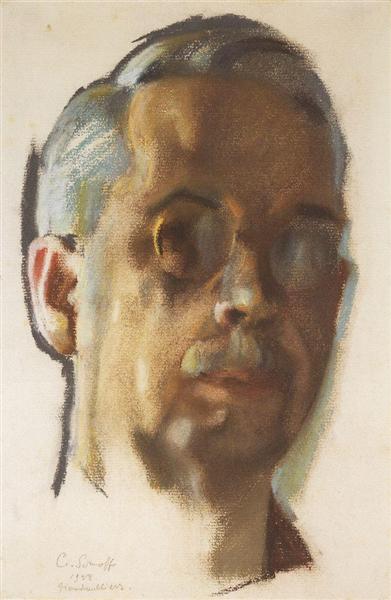Description
Konstantin Somov's 1928 "Self-Portrait" is a work that encapsulates the essence of the artist at a particular moment in his life and career. Born in 1869 in St. Petersburg, Somov was a significant representative of the Russian Symbolist movement and is known for his elegant style, fine literary allusions, and mastery of color and light. His ability to combine elements of aesthetic beauty with psychological depth is particularly vividly reflected in this self-portrait.
The painting shows Somov in a moment of introspection, almost of self-absorption. The composition is austere, focusing predominantly on the figure of the artist, who is presented in the foreground, establishing an immediate connection with the viewer. His precisely delineated face is a perfect balance between a serene expression and a subtle melancholy. His facial features are soft, but laden with a penetrating gaze that suggests a rich and complex history behind that calm appearance.
The use of colour in this work is particularly notable. Warm tones of gold, beige and brown predominate, lending a sense of nostalgia, while deeper shadows accentuate the three-dimensionality of her face. Somov employs a delicate treatment of light, which adds an almost ethereal atmosphere to the image. This play of light and shadow is characteristic of the artist, who was a consummate master of depicting the texture and quality of skin, lending a sense of realism to his work, while evoking an implicit spirituality.
In the background of the painting, the surroundings are revealed in the form of a soft gradient that does not distract from the main subject, but in its simplicity provides a subtle context. The choice of a less defined background seems to suggest that the work is not only a self-portrait, but also a reflective mirror of the artist’s inner world. By looking beyond the portrait itself, the viewer can glimpse aspects of Somov’s soul and his struggle between the search for beauty and the expression of his personal experiences.
While the figure of Somov is the focus, the portrait also evokes a broader conversation about symbolism and the individual experience of art during the 1920s. In this sense, the “Self-Portrait” can be considered part of a larger corpus of works that seek to explore introspection and identity in a time of social and political change. Somov’s work, at its core, reflects his own insecurities and aspirations, and seems to anticipate the turbulent future, both artistic and existential, that lay ahead for him and many of his contemporaries.
The 1928 “Self-Portrait” is therefore more than just a portrait; it is a provocative and intoxicating representation of the artist’s mind and his place in the art world. This work invites us to contemplate not only the figure of the painter, but also the cultural context that surrounds him, establishing a dialogue between the individual and his environment, art and life. In the history of Russian art, Somov occupies a prominent place, and this self-portrait is a clear expression of his creative genius, a mirror that reflects not only his face, but also the complexity of his being.
KUADROS ©, a famous painting on your wall.
Hand-made oil painting reproductions, with the quality of professional artists and the distinctive seal of KUADROS ©.
Painting reproduction service with satisfaction guarantee. If you are not completely satisfied with the replica of your painting, we will refund 100% of your money.

